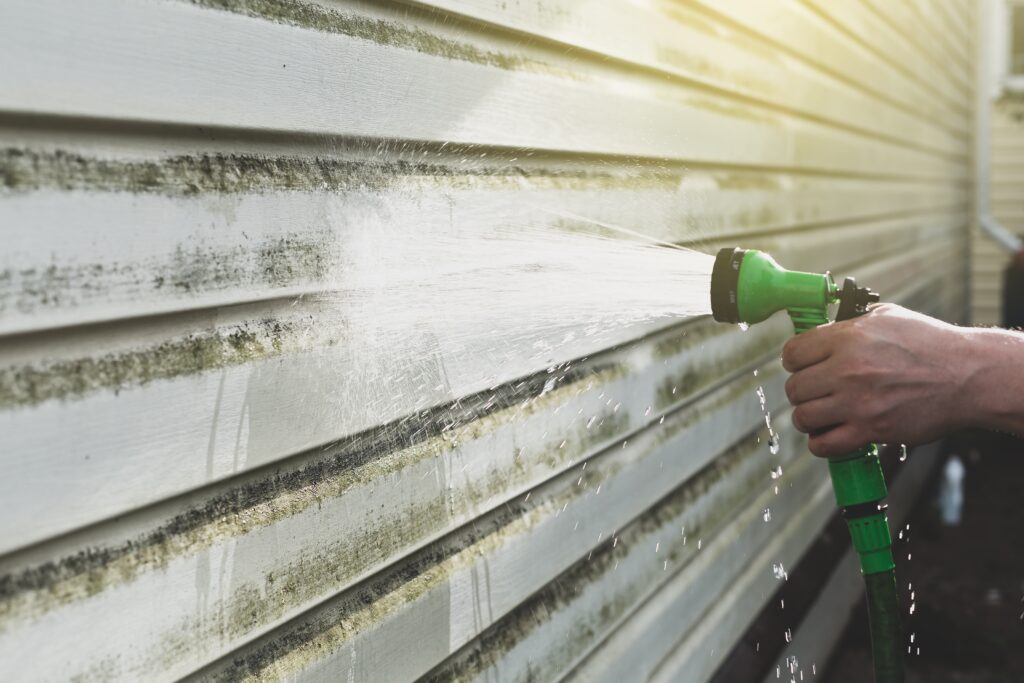How to Clean Mold on Siding

Mold loves to grow where there’s moisture, shade, and a little buildup of dirt or pollen to feed on. While it might start as just a few spots, ignoring it can quickly lead to a bigger eyesore. Taking the time to clean mold on siding not only helps keep your home looking sharp, it also protects your siding from long-term damage and supports a healthier living environment.
A little regular siding maintenance goes a long way, and knowing how to safely remove mold from siding is the first step.
Table of Contents
Why Mold Grows on Siding
Mold doesn’t just show up out of nowhere—it thrives when the conditions are right. If your home gets a lot of shade, has areas with poor ventilation, or you live in a spot with constant humidity, mold can quickly become an issue. Clogged gutters don’t help either—when water runs down your siding instead of away from it, it creates the perfect damp environment for mold to take hold.
Some siding materials are more prone to mold than others. For example, mold on vinyl siding is a pretty common issue because dirt and pollen can stick to the surface, giving mold something to cling to. Wood siding is another favorite since it’s porous and naturally holds moisture, while fiber cement siding can also develop mold problems if it’s not properly sealed or maintained.
Knowing what causes mold problems on siding helps you stay one step ahead. A little prevention—like clearing out those gutters or trimming back overgrown trees—can make a big difference.
Dangers of Mold on Siding
Mold on your siding might seem like just a cosmetic issue at first, but it comes with a handful of hidden problems. For starters, there are health concerns. Mold spores can trigger allergies, cause breathing problems, and make life pretty uncomfortable for anyone in your home who already struggles with asthma or sensitivities. That’s one of the bigger mold siding risks homeowners often overlook.
Then there’s the damage to your house itself. Mold can leave behind stubborn stains and ugly discoloration, and if you’ve got wood siding, it can even contribute to rot over time. That kind of siding mold damage isn’t just expensive to fix, it can also shorten the life of your exterior.
And let’s not forget curb appeal. Moldy siding drags down the look of your home, and if you’re thinking of selling, buyers will notice right away. Even if the structure is sound, mold makes your home appear neglected, which can hurt resale value.
Tools and Supplies You’ll Need
Before you start scrubbing away at mold, it helps to have the right setup. Most of the siding cleaning tools you’ll need are simple and probably already sitting in your garage. A sturdy bucket, a garden hose with a spray nozzle, and a good scrub brush are the basics. Don’t forget protective gear—gloves, safety glasses, and maybe even a mask—since you don’t want mold spores or cleaning solution splashing back at you.
Next up, you’ll need a cleaner. The best cleaner for mold on siding depends on how bad the problem is and what you’re comfortable using. For light spots, a simple vinegar and water mix does the trick. If you want something stronger but still eco-friendly, oxygen bleach is a solid choice. And for those who prefer a grab-and-go option, there are plenty of commercial siding cleaners designed to cut through mold quickly.
Thinking about a pressure washer? It can be a huge time-saver, but you’ll want to be cautious. Used correctly, it blasts mold off large areas fast. Used incorrectly, it can damage your siding or push water where it doesn’t belong. Always check your siding manufacturer’s recommendations before going full throttle with the washer.
With the right tools and cleaning solution in hand, you’ll be ready to tackle mold without a lot of frustration.
Step-by-Step Guide to Cleaning Mold Off Siding
Step 1 – Prepare the Area
Before you dive into cleaning, take a few minutes to protect the space around your home. Cover any landscaping, flowers, or shrubs with tarps so cleaning solutions don’t damage them. Close windows and doors to keep water and cleaning spray outside.
Step 2 – Apply Cleaning Solution
Now it’s time to treat the mold. For a natural option, mix up a simple vinegar solution (one part white vinegar to three parts water) and pour it into a spray bottle or garden sprayer. Vinegar is great for small patches of mold, especially if you want to avoid harsh chemicals. If you need something stronger but still safe for your siding, oxygen bleach is a fantastic alternative to chlorine bleach—it kills mold without the same risk of damaging your siding or harming nearby plants. And of course, you can always pick up a store-bought siding cleaner designed specifically to remove green mold from siding. Just follow the directions on the label for best results.
Step 3 – Scrub or Spray the Siding
For smaller spots, grab a soft-bristle brush and scrub the moldy areas by hand. This gives you more control and avoids the risk of scratching or denting your siding. If you’re tackling a bigger job, a pressure washer can be your best friend—but only if you use it carefully. To power wash siding mold without causing damage, keep the nozzle at least a foot away from the surface and aim straight at the siding (not upward) so water doesn’t sneak behind panels. Start on the lowest setting and work your way up if needed.
Step 4 – Rinse and Dry
Once the scrubbing or spraying is done, give your siding a thorough rinse with clean water. This step is key because any leftover solution can leave streaks or residue. Let the siding dry completely before calling the job finished—mold loves damp surfaces, so full drying helps prevent it from coming back.
With these simple steps, you’ll know exactly how to clean vinyl siding mold and keep your exterior looking sharp without damaging your home in the process.
How to Prevent Mold from Returning
Cleaning your siding once is great, but the real win is keeping the mold from coming back in the first place. Luckily, a few simple siding maintenance tips can make a big difference.
Start with your gutters—when they’re clogged, water has nowhere to go but down your siding, creating damp streaks that mold loves. Keeping them clear helps keep your siding dry.
Next, look at your landscaping. If trees or shrubs are shading large parts of your house, trimming them back lets in more sunlight and improves airflow. Since mold thrives in dark, damp spots, a little extra sunshine is one of the easiest ways to prevent mold on siding.
It’s also smart to give your siding a quick wash at least once a year. Even if you don’t see mold yet, rinsing away dirt, pollen, and grime removes the stuff mold feeds on. Think of it as a yearly checkup for your home’s exterior.
And if you’re planning new siding down the road, ask about mold-resistant products. Some newer options are designed to resist moisture and growth, which can save you time and effort in the long run.
A little prevention now means less scrubbing later—and a cleaner, healthier home exterior you can feel good about.
When to Call a Professional
Sometimes, mold on siding is an easy weekend project. Other times, it’s a much bigger job than a bucket and brush can handle. If you’re dealing with a large infestation that’s spread across most of your home’s exterior, it may be time to bring in professional siding cleaning services. They have the heavy-duty equipment and specialized solutions to get the job done quickly.
You’ll also want to pick up the phone if you notice mold creeping indoors or onto structural materials. At that point, it’s not just about looks. It could be a sign of moisture problems that need serious attention. Professionals can spot the root cause and make sure the issue doesn’t come right back.
And if your siding is already cracked, warped, or showing signs of rot, cleaning alone won’t solve the problem. That’s when you’ll want to consult a siding contractor for mold removal and possibly replacement. They can help you decide whether repairing a section or investing in new siding is the smarter move for your home.
In short: if the mold problem feels overwhelming, keeps coming back, or has already caused damage, calling in a pro is the best way to protect your home.
FAQs About Cleaning Mold on Siding
Can I use bleach to clean siding?
Yes, you can use bleach, but it’s not always the best choice. Bleach is strong enough to kill mold, but it can also strip color, damage nearby plants, and irritate your skin or lungs. Many homeowners prefer safer alternatives like vinegar or oxygen bleach, which are just as effective for cleaning mold without the harsh side effects. If you do go with bleach, always dilute it properly and rinse thoroughly.
Is pressure washing safe for all siding types?
Pressure washing is a quick way to blast away mold, but it’s not ideal for every type of siding. Vinyl siding usually holds up fine—as long as you keep the nozzle a safe distance away. Wood siding, on the other hand, can splinter or let water seep in if you use too much force. Fiber cement siding is generally sturdy, but it’s still best to use a lower setting. When in doubt, spot-test first and stick to gentle techniques to avoid damage.
How often should siding be cleaned?
A good rule of thumb is to wash your siding once a year. This keeps dirt, pollen, and other buildup from turning into a food source for mold. If your home is in a shady, humid area, you might want to clean it more often. Regular siding maintenance is the easiest way to prevent mold before it has a chance to spread.
Will mold damage vinyl siding?
Mold itself doesn’t usually eat away at vinyl siding the way it can with wood, but it will leave behind ugly stains that are tough to remove if you let them sit too long. Plus, mold growing on vinyl often means there’s lingering moisture, which could cause bigger issues if it’s getting behind your siding. So while the siding itself won’t rot, ignoring mold can still lead to problems down the road.
Conclusion
Keeping your siding clean isn’t just about looks, it’s also about protecting your home. Regular cleaning boosts curb appeal, helps maintain your property’s value, and keeps mold from turning into a bigger safety or health concern. The sooner you tackle mold, the easier it is to deal with, whether you’re scrubbing a small patch yourself or calling in a pro for a larger job.
Think of siding care as part of your home’s routine maintenance, like mowing the lawn or clearing the gutters. A little effort now saves you a lot of stress later—and keeps your home looking its best.

Anna has over six years of experience in the home services and journalism industries and serves as the Content Manager at MyHomePros.com, specializing in making complex home improvement topics like HVAC, roofing, and plumbing accessible to all. With a bachelor’s degree in journalism from Auburn University, she excels in crafting localized, comprehensive guides that cater to homeowners’ unique needs. Living on both coasts of the United States has equipped her with a distinctive perspective, fueling her passion for turning any house into a cherished home through informed, personalized decision-making.








